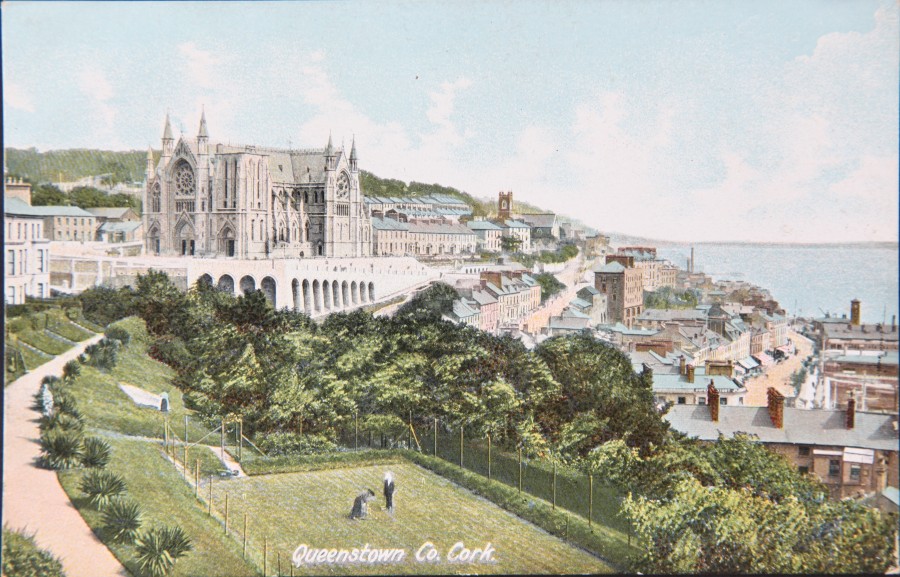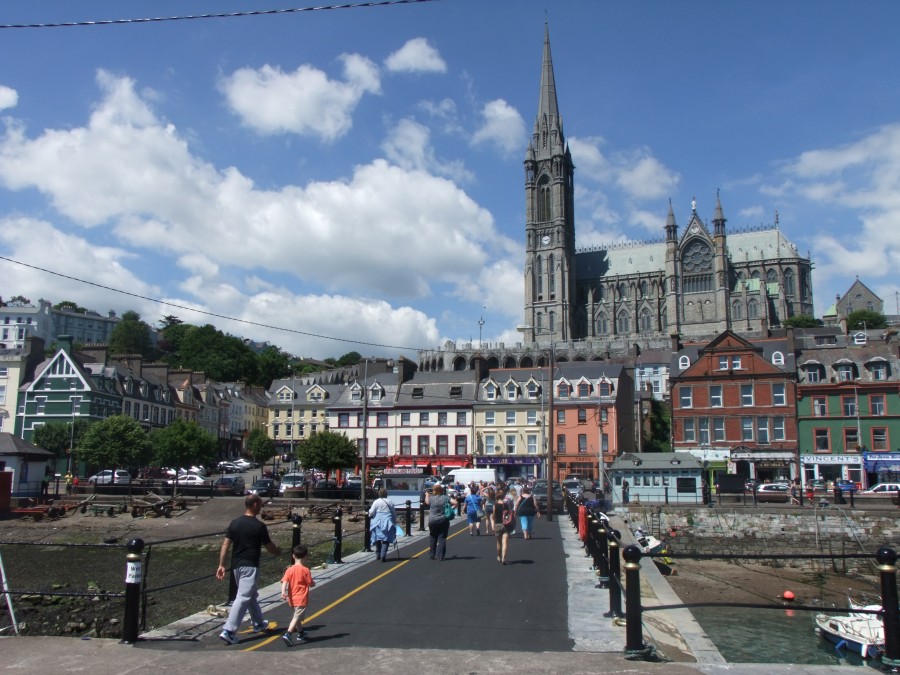Kieran’s Our City, Our Town Article,
Cork Independent, 22 August 2019
Tales from 1919: The Consecration of St Colman’s Cathedral
One hundred years ago this week on 24 August 1919 impressive ceremonies took place at Queenstown (now Cobh) to consecrate St Colman’s Cathedral. Local newspapers such as the Cork Examiner covered the event and the cathedral history was well documented in their August 1919 spread. Since then many historians, locally and internationally, have written on the gorgeous building.
The building of a Cathedral in Queenstown was the-conception of Dr William Keane, Bishop of Cloyne from 1857 to January 1874. He had personal knowledge of the grand Gothic Cathedrals of France, where he had lived for the greater part of his life as student and Superior in the Irish College, Paris. About the year 1860 Bishop Keane appealed to the people of the parish of Queenstown to inaugurate a fund for the purpose of meeting the initial expenditure on his great project. Within ten years the Queenstown fund reached the large figure of £15,000.
The Cathedral is one of Edward W Pugin and George Ashlin’s most important Irish commissions. It is one of the finest examples of ecclesiastical architecture in the Gothic revival style in Ireland. It was built at a time when leading architects had absorbed the principles of pointed architecture laid down by A W N Pugin (1812-1852), the father of E W Pugin and father-in-law of George Ashlin.
When groundwork began preparing for the building of the Cathedral, the old church or the chapel of Queenstown was taken down to provide a site for the Cathedral itself. The building used as the Queenstown Intermediate School, run by the Presentation Brothers, was erected to serve as a temporary parochial church. The costliest part of the preliminary works was in connection with the laying of the foundations, which had to be built up from a depth of 24 feet. The outlay on these preliminary works amounted to more than half the £15,000 already subscribed from Queenstown.
On 30 September 1868, Bishop Keane laid the cornerstone of the Cathedral. By January 1874 the month of Bishop Keane’s death. the outer walls of the Cathedral had been raised all round to the height of 14 or 15 feet. The outlay amounted to £20,486 4s 8d, representing £8,000 spent on the preliminary works and £12,460 paid to the contractors.
In September 1874, Bishop John MacCarthy was consecrated Bishop of Cloyne in succession to Bishop Keane and took up the work. The external walls all round were raised to their full height; the magnificent roof of best Belgian slate, with its stone-cut water-valleys and numerous statues, were constructed. The tower, which stood when he took it in hands, only about 15 feet high, was raised by a storey. The crypt was constructed as well as the beautiful west front. Dalkey blue Granite and Mallow limestone were used in the external walls. The building contractors employed in the vast project comprised local quarrymen, car men, labourers, limestone and bath stone masons, sawyers, nailers, carpenters, smiths, plumbers, tradesmen’s helpers and numerous general stone masons.
Notable additions were also made in the interior such as the high altar, side-chapels within the sanctuary. The tiled mosaic floor of the chancel was tiled. The bishop’s throne, the beautiful south transept stained-glass window, and the marble Communion railing were installed. On 15 June 1879, the first Mass was celebrated.
In his Pastoral Letter of 1891-2, Bishop MacCarthy whilst making an appeal to the diocese for help, highlighted that the outlay on the Cathedral from its inception till then was over £100,000. He had received £8,000 from an appeal in 1882 to the diocese. He got £15,000 from the priests of his diocese, £50,000 from the generous laity of his diocese, £14,000 from Irishmen in the United States and Australia, £7,000 from dioceses in Ireland other than Cloyne, £8,600 from legacies and special donations, and to these sums.
Following the example set by Bishop MacCarthy, his successor, Bishop Robert Browne, took up the work which Bishop McCarthy had left off. Right in front of the great western door stood the town bridewell and two very dilapidated houses, which he detailed should be taken down. Moreover, the space round the Cathedral was very narrow and unsuitable. A great bastion wall was created from the bottom of the nearby ravine, some 30 or more feet deep. A sacristy and Cathedral Hall were constructed as well as the Chapel of the Blessed Thaddeus. This work would cost over £8,000. The tower was unfinished, and it had no spire. The tower and spire became the highest in Ireland and were furnished with a peal of 42 bells. All in all the work on the Cathedral took a full 50 years to complete.
The beautiful interior boasts different forms of marble. Fermoy red marble is used in nave columns which rest on Italian white marble. Midleton red marble is used in the shrines and in the first confessionals of both aisles. Connemara green marble is used in the sanctuary pillars. Kilkenny black marble is engaged in columns at the end of the north aisle. Italian white marble is used in communion rails and altar tables. Caen (Brittany) Stone is used in Stations of Cross. Californian Pitch pine is used in the ceiling of the nave and in seating. Austrian Oak is used in screens, the Bishop’s throne, the canons’ stalls and the pulpit.
Kieran’s Upcoming Historical Walking Tours:
Thursday 22 August 2019, The Lough and its Curiosities; meet at green area at northern green of The Lough, entrance of Lough Road to The Lough; 6.45pm (free, two hours)
Friday 23 August 2019, Douglas and its History, in association with Douglas Tidy Towns; meet in the carpark of Douglas Community Centre, 6.45pm (free, two hours).
Saturday 24 August 2019, Park Stories, explore the history of Cork’s Mardyke; meet at band stand in park, opposite Cork City Museum in Fitzgerald’s Park, 11am (free, two hours).
Captions:
1011a. Tinted postcard of the unfinished St Colman’s Cathedral, Queenstown, c.1900 (source: Cork City Museum).
1011b. Present day picture from the waterfront of the front of St Colman’s Cathedral, Cobh (picture: Kieran McCarthy).

